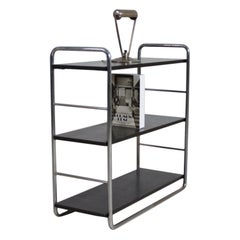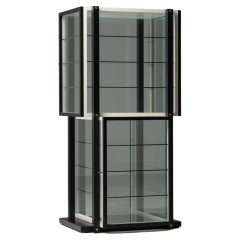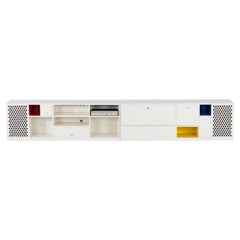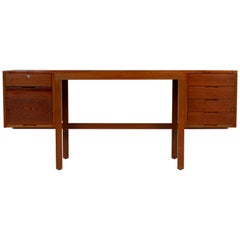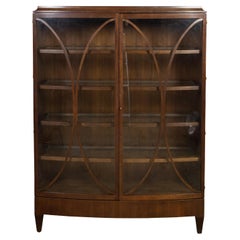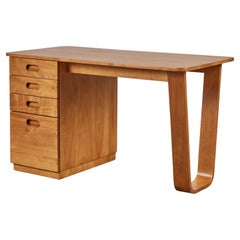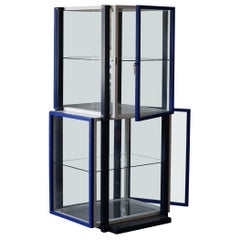Marcel Breuer Case Pieces and Storage Cabinets
The architect and designer Marcel Breuer was one the 20th century’s most influential and innovative adherents of modernism. A member of the Bauhaus faculty, Breuer — like such colleagues as the architects Walter Gropius and Ludwig Mies van der Rohe, and the artists and art theoreticians László Moholy-Nagy and Josef Albers — left Europe in the 1930s to champion the new design philosophy and its practice in the United States.
Born in Hungary, Breuer became a Bauhaus student in 1920 and quickly impressed Gropius, the German school’s founder, with his aptitude for furniture design. His early work was influenced by the minimalist Dutch design movement De Stijl — in particular the work of architect Gerrit Rietveld.
In 1925, while he was head of the Bauhaus furniture workshop, Breuer realized his signature innovation: the use of lightweight tubular-steel frames for chairs, tables and sofas — a technique soon adopted by Mies and others. Breuer’s attention gradually shifted from design to architecture, and, at the urging of Gropius, he joined his mentor in 1937 on the faculty of Harvard and in an architectural practice.
In the 1940s, Breuer opened his own architectural office, and there his style evolved from geometric, glass-walled structures toward a kind of hybrid architecture — seen in numerous Breuer houses in New England — that pairs bases of local fieldstone with sleek, wood-framed modernist upper floors. In his later, larger commissions, Breuer worked chiefly with reinforced concrete and stone, as seen in his best-known design, the brutalist inverted ziggurat built in New York in 1966 as the home of the Whitney Museum of American Art.
Breuer’s most famous furniture pieces are those made of tubular steel, which include the Wassily chair — named after Wassily Kandinsky and recognizable for its leather-strap seating supports — and the caned Cesca chair.
Breuer also made several notable designs in molded plywood, including a chaise and nesting table for the British firm Isokon and a student furniture suite commissioned in 1938 for a dormitory at Bryn Mawr College. Whether in metal or wood, Breuer’s design objects are elegant and adaptable examples of classic modernist design — useful and appropriate in any environment.
Find vintage Marcel Breuer seating, storage cabinets and lighting on 1stDibs.
Early 20th Century German Bauhaus Marcel Breuer Case Pieces and Storage Cabinets
Steel
1920s German Bauhaus Vintage Marcel Breuer Case Pieces and Storage Cabinets
Glass, Beech
1970s American Mid-Century Modern Vintage Marcel Breuer Case Pieces and Storage Cabinets
Metal
1950s American Mid-Century Modern Vintage Marcel Breuer Case Pieces and Storage Cabinets
Walnut
1930s German Bauhaus Vintage Marcel Breuer Case Pieces and Storage Cabinets
Steel
Early 20th Century Bauhaus Marcel Breuer Case Pieces and Storage Cabinets
Steel
Late 20th Century American Modern Marcel Breuer Case Pieces and Storage Cabinets
Glass, Wood
1960s German Mid-Century Modern Vintage Marcel Breuer Case Pieces and Storage Cabinets
Glass, Teak
Early 20th Century Bauhaus Marcel Breuer Case Pieces and Storage Cabinets
Steel
1960s Danish Mid-Century Modern Vintage Marcel Breuer Case Pieces and Storage Cabinets
Teak
1930s Bauhaus Vintage Marcel Breuer Case Pieces and Storage Cabinets
Steel, Chrome
1970s American Mid-Century Modern Vintage Marcel Breuer Case Pieces and Storage Cabinets
Chrome
1950s Dutch Industrial Vintage Marcel Breuer Case Pieces and Storage Cabinets
Pine
1930s American Art Deco Vintage Marcel Breuer Case Pieces and Storage Cabinets
Stainless Steel
Mid-20th Century Swedish Mid-Century Modern Marcel Breuer Case Pieces and Storage Cabinets
Teak, Lacquer
Early 20th Century American Art Deco Marcel Breuer Case Pieces and Storage Cabinets
Glass, Mahogany, Rosewood
1930s Bauhaus Vintage Marcel Breuer Case Pieces and Storage Cabinets
Steel, Chrome
Mid-20th Century American Mid-Century Modern Marcel Breuer Case Pieces and Storage Cabinets
Birch, Plywood
Mid-20th Century European Bauhaus Marcel Breuer Case Pieces and Storage Cabinets
Metal
1980s British Vintage Marcel Breuer Case Pieces and Storage Cabinets
Plywood
Early 20th Century German Bauhaus Marcel Breuer Case Pieces and Storage Cabinets
Chrome
1930s German Bauhaus Vintage Marcel Breuer Case Pieces and Storage Cabinets
Steel
1930s German Bauhaus Vintage Marcel Breuer Case Pieces and Storage Cabinets
Chrome, Nickel
1940s American Vintage Marcel Breuer Case Pieces and Storage Cabinets
Marcel Breuer case pieces and storage cabinets for sale on 1stDibs.
Creators Similar to Marcel Breuer
- Who is Marcel Breuer?1 Answer1stDibs ExpertMarch 22, 2022Marcel Breuer was an architect and furniture designer who made a major impact on modern design by introducing new materials and emphasizing the importance of form matching function. He was born in Pécs, Hungary, in 1902, and was a part of the Bauhaus school. You’ll find a collection of Marcel Breuer furniture on 1stDibs.
- 1stDibs ExpertMarch 22, 2022To pronounce Marcel Breuer, say "mar-SELL BROO-ur." The artist's first and last name both originate from the Hungarian language. Breuer was born in Pécs, Hungary, on May 21, 1902. You can shop a variety of Marcel Breuer furniture on 1stDibs.
- What inspired Marcel Breuer?1 Answer1stDibs ExpertMarch 22, 2022The Dutch art movement De Stijl inspired Marcel Breuer's early work. Artists in the movement like Piet Mondrian created art that adhered to the principles of geometry. This idea resonated with Breuer and informed his designs. Shop a selection of Marcel Breuer furniture on 1stDibs.
- Where was Marcel Breuer born?1 Answer1stDibs ExpertMarch 22, 2022Marcel Breuer was born in Pécs, Hungary, on May 21, 1902. He attended the Bauhaus design school in Weimar, Germany, and eventually became a part of the faculty. After the Nazis shut the school down, Breuer moved to the U.S. He died in New York City on July 1, 1981. On 1stDibs, find a variety of Marcel Breuer furniture.
- What is Marcel Breuer known for?1 Answer1stDibs ExpertMarch 22, 2022Marcel Breuer is known for his work as an architect and furniture designer during the 20th century. During his life, he created many famous chairs that remain popular today, including the Wassily lounge chair, the Cesca chair and the D40 cantilever chair. You’ll find a range of Marcel Breuer furniture on 1stDibs.
- What did Marcel Breuer design?1 Answer1stDibs ExpertMarch 22, 2022Over the course of his life, Marcel Breuer designed many things. Furniture was one of his main focuses, and he created many influential pieces, including the Wassily lounge chair, the Cesca chair and the Laccio side table. Shop a collection of Marcel Breuer furniture on 1stDibs.
- 1stDibs ExpertApril 12, 2024Marcel Breuer is famous for being one of 20th-century modernism’s most influential innovators. His most well-known furniture pieces were crafted of tubular steel, including the Wassily chair and the caned Cesca chair. Breuer also made several notable designs in molded plywood, including a chaise longue and nesting table for the British firm Isokon and a student furniture suite commissioned in 1938 for a dormitory at Bryn Mawr College. Breuer’s designs are elegant and adaptable examples of modernism, useful and appropriate in any environment. On 1stDibs, shop a collection of Marcel Breuer furniture.
- 1stDibs ExpertMarch 22, 2022Yes, Marcel Breuer taught at the Bauhaus design school in Weimar, Germany. He arrived at the institution in 1920 as a student. By 1925, his duties expanded to include teaching classes of his own and running the school's furniture shop. On 1stDibs, find a selection of Marcel Breuer furniture.
- 1stDibs ExpertMarch 22, 2022Today, Marcel Breuer chairs are made in the factory locations of the furniture manufacturer Knoll, Inc. It operates production facilities in Italy and Canada, as well as in Pennsylvania and Michigan in the U.S. Find a collection of Marcel Breuer furniture on 1stDibs.
- 1stDibs ExpertApril 22, 2024Marcel Breuer designed several chairs. One of his best-known pieces is the Wassily lounge chair made of tubular steel and leather straps. Breuer named the chair after the artist Wassily Kandinsky. Among the designer's other notable chairs are the Cesca chair, the B35 lounge chair and the S 35. On 1stDibs, find a diverse assortment of Marcel Breuer chairs.
- 1stDibs ExpertMarch 22, 2022Marcel Breuer was associated with the Bauhaus school in Weimar, Germany. After attending classes as a student, Breuer became the head of the school's furniture shop. While working there, he created the Wassily lounge chair, introducing the use of tubular steel frames to modern furniture design. Find a variety of Marcel Breuer chairs on 1stDibs.
- 1stDibs ExpertMarch 22, 2022Most Marcel Breuer chair legs are made out of bent tubular steel. The designer introduced this radical new material to modern furniture design with his Wassily Model B3 lounge chair. On 1stDibs, you can shop a collection of Marcel Breuer chairs.
- 1stDibs ExpertMarch 22, 2022There are a number of ways that you can tell an original Marcel Breuer chair. One trick is to examine the frame. If you see end caps, you're likely looking at a replica. Authentic Breuer chairs featured polished, welded ends. Some chairs also feature stickers that identify the model name located under their seats. On 1stDibs, find a collection of expertly vetted Marcel Breuer chairs.
- 1stDibs ExpertMarch 22, 2022Marcel Breuer became an apprentice and student at the Bauhaus school in 1920. He made a big impression on the school's founder, Walter Gropius, and later became the head of the institution's furniture workshop. Find a selection of Marcel Breuer furniture on 1stDibs.
- 1stDibs ExpertMarch 22, 2022Marcel Breuer chose a bicycle tube frame to create his Wassily lounge chair because he was impressed by the strength and weight properties of the steel. The chair was a landmark in furniture design and opened the doors to the use of tubular steel frames in many chairs, tables and sofas produced during the modern period. You’ll find a selection of Marcel Breuer furniture on 1stDibs.
- 1stDibs ExpertMarch 22, 2022Marcel Breuer created the Cesca chair while splitting his time between Paris and Germany. He made the chair in 1928, shortly after he left the Bauhaus school, but you can clearly see the influence of the institution's design principles in the clean, simple lines of the piece. Find a range of Marcel Breuer Cesca chairs on 1stDibs.
- 1stDibs ExpertMarch 22, 2022To identify Marcel Breuer bar stools, start by examining the frame. Genuine models will usually feature smooth, welded ends. Most reproductions have end caps instead. You can also look for a sticker that bears the model name on the underside of the seat. On 1stDibs, find a range of expertly vetted Marcel Breuer bar stools.
- 1stDibs ExpertMarch 22, 2022To reupholster a Marcel Breuer Cesca chair, first pry out the staples, remove the original upholstery and disassemble the chair. Place the new fabric on a flat surface and position the seat upside down. Fold the fabric over the edge and secure it with a staple gun. On 1stDibs, shop a selection of expertly vetted Marcel Breuer Cesca chairs.
- 1stDibs ExpertMarch 22, 2022What was most innovative about Marcel Breuer's Model B3 chair was its frame. Also known as the Wassily lounge chair, the piece featured a lightweight, sturdy tubular steel frame inspired by the artist's Adler bicycle. His use of the metal started a radical shift in furniture design. You’ll find a variety of Marcel Breuer Model B3 chairs 1stDibs.
- 1stDibs ExpertMarch 22, 2022Marcel Breuer introduced the material of tubular steel to modern furniture design. He employed it in many of his chairs, tables and sofas, prizing the material because it minimized the weight of pieces without sacrificing their strength. Shop a range of Marcel Breuer furniture on 1stDibs.
